In this video, you’ll learn how to calculate the vehicle’s total cost of ownership and properly assess all the potential benefits and tradeoffs of adopting EV technology for your fleet.
Federal Energy Management Program
June 28, 2022Electric vehicle (EV) technology can significantly reduce the operation and maintenance costs of owning a vehicle. In this video, you’ll learn how to calculate the vehicle’s total cost of ownership and properly assess all the potential benefits and tradeoffs of adopting EV technology for your fleet.
Electric vehicle technology offers great opportunities for fleets, such as decreased fueling costs, reduced maintenance, and the elimination of tailpipe emissions. But what about the financial implications of adopting EV technology for your fleet?
EVs can significantly reduce the operation and maintenance costs of owning a vehicle. However, you should consider the vehicle's total cost of ownership to properly assess all the potential benefits and tradeoffs.
Unlike internal combustion engine vehicles, which run on gasoline, EVs run on electricity. Operating vehicles on electricity is generally less expensive than gasoline, and the price point for electricity is generally more stable. This benefit is best explained by calculating a vehicle's fueling cost per mile.
Consider the Chevy Sonic. This is a low-greenhouse gas emitting internal combustion vehicle, with an EPA-estimated efficiency of 29 miles per gallon, or 0.034 gallons per mile. It runs on gasoline priced at about $3 per gallon, which was the average price of gasoline from 2010 to 2019. To calculate this vehicle's fueling cost per mile, multiply the vehicle efficiency, in gallons per mile, by the price of gasoline. So, at $3 per gallon, the cost of fueling the Chevy Sonic is about 10 cents per mile.
Now consider the Chevy Bolt, an EV with an EPA-estimated efficiency of 118 miles per gallon equivalent, or 0.28 kilowatt-hours per mile. The Bolt runs solely on electricity priced at 10 cents per kilowatt-hour. Similar to the gasoline calculation, multiply the efficiency in kilowatt-hours per mile by the cost of a kilowatt-hour. This results in a fueling cost of about 3 cents per mile.
But the fueling cost of a vehicle is not the only factor. The larger batteries used in EVs require a greater upfront capital investment, also known as the incremental cost. This incremental cost represents the increase in price for a specific model compared to the lowest-priced option in that vehicle class. However, battery prices are expected to decline to less than half of 2018 levels in the coming decade. This will place EVs close to price parity with combustion engine vehicles, even before considering the maintenance and fueling benefits.
Each year, GSA awards new vehicle contracts and publishes current EV availability and pricing through the GSA AFV Guide. Vehicle incremental cost is spread across the entire leased fleet and is paid in the first year the new leased vehicle is acquired. This cost can be recovered through higher vehicle utilization over the life of the vehicle lease.
The Chevy Bolt is the lowest-priced battery electric vehicle available on the 2020 Schedule, with an incremental cost of $11,498, while the Kia Niro has the lowest incremental cost among plug-in hybrid electric vehicles at $6,563.
GSA also posts mileage rates for each GSA leased vehicle model. For internal combustion engine vehicles, this mileage rate includes fuel costs and common maintenance expenses. The FY20 GSA lease rate for the Chevy Sonic is $250 dollars per month, with a 13.4 cent mileage rate. To calculate the annual cost of the Sonic, add the 12 monthly leasing fees to the annual mileage rate expenses for an assumed 16,000 annual vehicle miles traveled.
For an EV the calculation is similar. However, the GSA mileage rate only includes EV maintenance, so the cost of electricity must also be included when calculating the annual cost of EVs. The Chevy Bolt may be leased for $215 per month with only a 2.7 cent mileage rate. To calculate the annual cost of the Bolt, add the 12 monthly leasing fees to the annual mileage rate expenses for an assumed 16,000 annual vehicle miles traveled.
Given these assumptions, if a fleet switched from leasing a Chevy Sonic to a Chevy Bolt, the annual savings would be almost $1,700 per year. These savings would cover the incremental cost of the Bolt in less than 7 years, which is the maximum lease period GSA offers for EVs.
The primary energy source for EVs is the electricity stored in the battery. This electricity is supplied from the grid through electric vehicle supply equipment, or EVSE. Most fleets and facilities pay for this energy through their monthly utility bills. Therefore, it's important to understand how EV charging can impact your utility bill.
Utility companies typically have multiple rate options available for commercial customers. Consider your facility's energy requirements and demand profile throughout an entire billing period, then speak with your utility about which rates are best for your fleet's needs.
The most common rate element is an energy charge. This is a key element in any rate structure and captures the price for all of the electricity consumed in one billing period. This rate element charges a consistent price for every unit of energy consumed and is typically listed in cents per kilowatt-hour.
Some utilities also offer Time-of-Use rates, which vary the price of energy charges throughout the day. These rates are typically designed to address a surplus in demand or supply. They also pose opportunities for fleets to save money by consuming energy during off-peak periods. On the other hand, time-of-use rates present a risk of higher electricity bills if a large amount of energy is consumed during on-peak periods. If possible, schedule your fleet EV charging for periods of the day when the price is the lowest.
In addition to energy charges, many commercial rates also include a demand charge. A demand charge is a monthly fee determined by the point in time when a fleet consumed the largest amount of power. This rate is listed in dollars per kilowatt and can increase significantly if your fleet EVs are charging at the same time when your facility is at peak demand.
In addition to rate structures, many utilities also provide alternate service options to better serve the needs of EVs. This may include alternate billing or metering strategies to align with your fleet's fueling practices, as well as additional infrastructure support. For example, the utility may install and own the wiring and equipment up to, but not including, the EVSE.
Federal agencies can purchase EVSE through a Blanket Purchase Agreement pre-negotiated by GSA, on the GSA Advantage website, or through the open market. Although some utilities provide service options with the infrastructure necessary for EVSE, many fleets install and own all of their equipment. EVSE infrastructure projects can become both financially and technically challenging. Thankfully, there are a number of programs available to help your fleet plan and install EVSE.
The Clean Cities Program, operated by the U.S. Department of Energy, is a great first resource for fleets to consider. By contacting the local coalition representative listed on the Clean Cities website, fleets open the door to a wide range of technical expertise and support, as well as extensive knowledge of national, state, and local funding opportunities.
If your fleet requires specialized expertise to support a more aggressive EV program, the Federal Energy Management Program can help. FEMP's EVSE Tiger Teams are comprised of electric vehicle subject matter experts who can help fleets plan for EV acquisitions and charging station installation.
Like most infrastructure projects, EVSE installation requires an up-front capital investment. However, this investment may be supported by EVSE loans and grants through programs such as the Volkswagon Diesel Emissions grants, state-funded programs, or even funding support from a local electric utility.
Federal agencies are required to report EV and EVSE cost data in the Federal Automotive Statistical Tool, or FAST. EV costs are reported like other vehicles, but EVSE costs are reported in a separate fueling station report. Agencies must report the number of EVSE, the fees they bill employees for charging privately owned vehicles, and the costs for new EVSE installations.
Learn more about federal fleet EV and EVSE reporting on the FAST website.
FEMP can help agencies understand EVSE fees and other facets of workplace charging. Visit the FEMP website for more information.
Learn more about FEMP Electric Vehicle Training.
More Videos
-
 This Take Five training covers the why and how of life cycle costing, comparison of life cycle cost savings for different energy-using products, and ensuring that products are cost effective.
This Take Five training covers the why and how of life cycle costing, comparison of life cycle cost savings for different energy-using products, and ensuring that products are cost effective. -
 This Take Five training provides an overview of energy efficiency guidelines for food storage and equipment for federal employees and food-service contractors.
This Take Five training provides an overview of energy efficiency guidelines for food storage and equipment for federal employees and food-service contractors. -
 REopt helps federal building owners and energy managers identify and understand the optimal energy solution for their facility or campus.
REopt helps federal building owners and energy managers identify and understand the optimal energy solution for their facility or campus. -
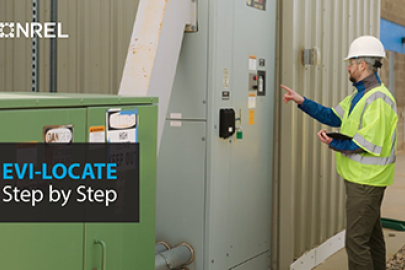 Learn how to use the Electric Vehicle Infrastructure – Locally Optimized Charging Assessment Tool and Estimator (EVI-LOCATE) web tool to guide you through the electric vehicle (EV) charging station planning process.
Learn how to use the Electric Vehicle Infrastructure – Locally Optimized Charging Assessment Tool and Estimator (EVI-LOCATE) web tool to guide you through the electric vehicle (EV) charging station planning process. -
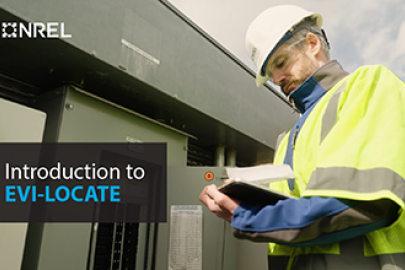 The Electric Vehicle Infrastructure – Locally Optimized Charging Assessment Tool and Estimator (EVI-LOCATE) website guides you through an interactive site assessment process and generates cost estimates and site layouts for EV charging projects.
The Electric Vehicle Infrastructure – Locally Optimized Charging Assessment Tool and Estimator (EVI-LOCATE) website guides you through an interactive site assessment process and generates cost estimates and site layouts for EV charging projects. -
 This webinar recording walks through the best practices for submitting an AFFECT application.
This webinar recording walks through the best practices for submitting an AFFECT application. -
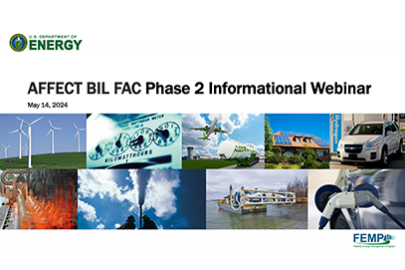 Webinar provides overview about Phase 2 of the Assisting Federal Facilities with Energy Conservation Technologies (AFFECT) Bipartisan Infrastructure Law (BIL) Federal Agency Call (FAC).
Webinar provides overview about Phase 2 of the Assisting Federal Facilities with Energy Conservation Technologies (AFFECT) Bipartisan Infrastructure Law (BIL) Federal Agency Call (FAC). -
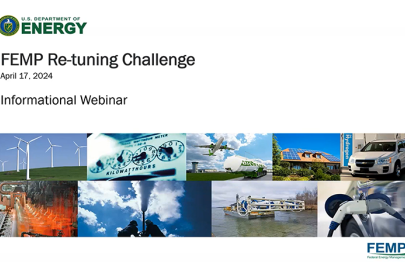 This informational webinar, hosted by the Federal Energy Management Program (FEMP), marks the launch of the 2024 FEMP Re-tuning Challenge.
This informational webinar, hosted by the Federal Energy Management Program (FEMP), marks the launch of the 2024 FEMP Re-tuning Challenge. -
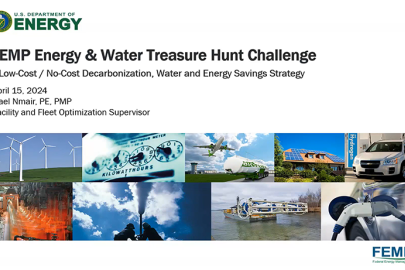 This webinar describes the foundational principles of the Federal Energy Management Program's (FEMP) Regional Energy and Water Treasure Hunt Program and helps agencies recognize no-cost, low-cost energy and water savings opportunities.
This webinar describes the foundational principles of the Federal Energy Management Program's (FEMP) Regional Energy and Water Treasure Hunt Program and helps agencies recognize no-cost, low-cost energy and water savings opportunities. -
 This training session provides an overview of how to complete the ePB template for different funding types, shows where to enter the AFFECT grant value, and describes how the information in key tabs will be used during the evaluation process.
This training session provides an overview of how to complete the ePB template for different funding types, shows where to enter the AFFECT grant value, and describes how the information in key tabs will be used during the evaluation process.

